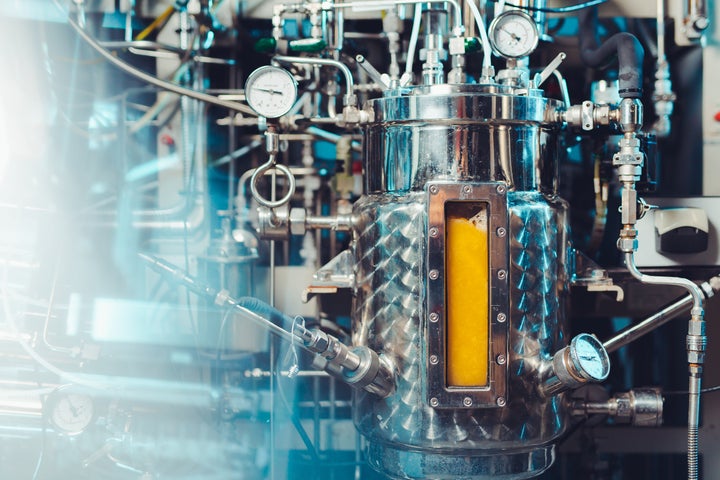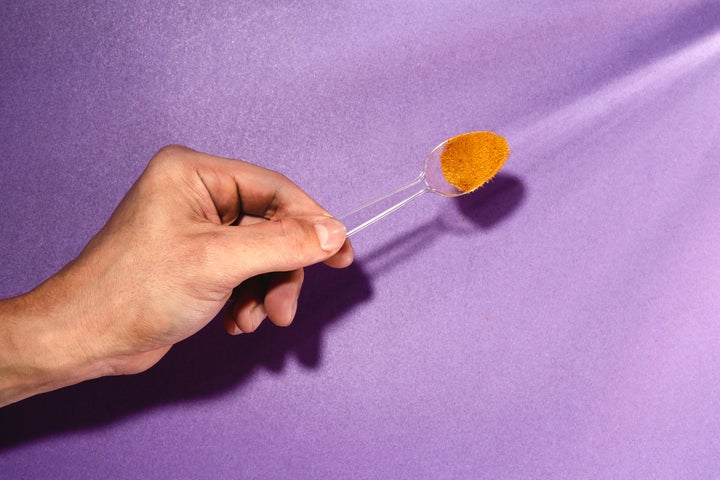A new protein made from air, water and renewable electricity could revolutionize our food system within the next decade.
Developed by the Finnish company Solar Foods in a lab just outside Helsinki, the protein ― called Solein ― is made using living microbes that are then grown in a fermenter in a process similar to brewing beer. The microbes are fed with carbon dioxide, hydrogen, oxygen and nitrogen ― all taken from the air.
This fermentation process, which takes place in huge vats, produces a liquid that is removed and dried to give the final product ― a yellow flour-like powder with multiple food uses.
If the electricity comes totally from renewables ― the aim is to use solar and wind ― the production process could produce virtually zero greenhouse gas emissions, the company says.
It would also require far less land and far less water than traditional agriculture. Solar Foods says just 10 liters (2.6 gallons) of water is needed for every 1 kilogram (2.2 pounds) of Solein. To produce 1 kilogram of soy requires 2,500 liters (550 gallons) of water, a figure that rises to more than 15,000 liters (3,300 gallons) for 1 kilogram of beef.
“We bring to the market an entirely new kind of food that is both natural, and free from the burdens of agriculture and aquaculture,” reads Solar Foods’ website.

The protein, which is virtually tasteless, is not intended as a stand-alone food. “We do not propose that people eat protein pills and powders,” Pasi Vainikka, CEO of Solar Foods, told HuffPost. “The consumer would not see the difference on their plate.”
Solein has three applications, said Vainikka. It can be used as a protein additive in existing foods such as bread, pasta and noodles or plant-based dairy products. It could, for example, work as a way to help ingredients bind together, thereby replacing palm oil, a ubiquitous ingredient in our foods that is responsible for environmental devastation and wildlife destruction as rainforests are razed for palm oil plantations.
It could also work as an ingredient in plant-based meat alternatives ― think Impossible Burger or Beyond Meat. The final use is as a feedstock for lab-grown meat ― meat grown in petri dishes from animal cells without the need for animal slaughter.
The technology is being hailed by some as a potential game changer for the world.
Our current food system comes with an enormous environmental impact. What we eat makes up 14.5% of all human-produced greenhouse gas emissions: Huge amounts of carbon dioxide are released as trees are felled to make way for farms and plantations, for example, and cows emit large quantities of the potent greenhouse gas methane. Agriculture is also a significant user of water, a polluter of both water and air, and one of the biggest drivers of our biodiversity crisis as land clearance destroys animals’ habitats.
As the global population increases, so too will agriculture’s already heavy demand for land, water and other resources. The United Nations Food and Agriculture Organization estimated food production needs to increase by about 50% by 2050 to meet demand.
Added to this, the world is reckoning with climate change impacts that threaten the viability of our food system ― from fires, like the ones raging across Australia, to floods, such as those that devastated farms across the Midwest last year. Water is drying up, rains are more erratic, either not falling enough or way too much, and the demise of the world’s insects means the loss of vital pollinators for crops.
Solar Foods pitches its protein as an alternative to a broken food system. “Our hope is to disconnect food production from agriculture,” said Vainikka, who added, “The environmental benefits are just a simple follow-up from that disconnection.”

The technology is still in the early stages, currently at pilot scale. The next step is to build a demonstrator plant, which is slated to open by early 2022. The company is also seeking regulatory approval from food authorities for what is essentially a brand-new food.
Once the demonstrator is up and running, a limited amount of the protein could be launched to the market, said Vainikka. The final development stage would be to build a full-scale factory, which could be completed by 2025 if all goes to plan.
But the path from development to commercialization can be a fraught one and we should remain cautious, warn some experts.
“As with all of the recent alternative protein technologies, the environmental gains they promise are dependent on how they scale up,” Alexandra Sexton, Oxford Martin research fellow at the University of Oxford, told HuffPost. The key for Solar Foods, she said, is to ensure it can scale and keep its commitment to 100% renewable energy use.
Even if scaling-up of the tech were successful, Sexton warned of possible political and social issues. “There is potential for large-scale livelihood loss from current agricultural sectors,” she said, “and linked to this a loss of cultural identities, heritage and communities.”
Who ends up with power over the technology is also vital, she added. “It is important that new technologies consider the social and economic disparities that the current food system creates, otherwise there is a danger that new technologies risk reproducing those inequalities.”
“A risk I foresee, for example,” she continued, “is that the new protein technologies have the potential to concentrate power and ownership in food production to a smaller number of players.”
Others take a more positive view of Solar Foods’ tech. The high-profile U.K. environmental journalist George Monbiot, believes it could have planet-saving potential. “Before long, most of our food will come neither from animals nor plants, but from unicellular life,” he predicted in a Guardian article published on Wednesday. “After 12,000 years of feeding humankind, all farming except fruit and veg production is likely to be replaced by ferming: brewing microbes through precision fermentation.”
Vainikka is obviously positive about the potential of his product. As a former scientist, though, he is naturally cautious when asked if it really could be planet-saving. “One needs to be a realist,” he said, noting it’s impossible to predict when this may become a key part of our food system. But, he added, “The opportunity is huge.”
“If we want to save this planet, we need to make this disconnection [from agriculture],” he said. “Whether it’s us, or someone else and companies like us, that needs to be done.”
For more content and to be part of the “This New World” community, follow our Facebook page.
HuffPost’s “This New World” series is funded by Partners for a New Economy and the Kendeda Fund. All content is editorially independent, with no influence or input from the foundations. If you have an idea or tip for the editorial series, send an email to thisnewworld@huffpost.com
